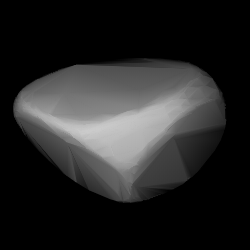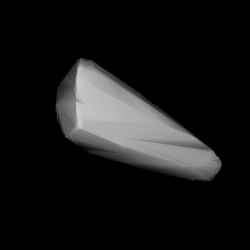Related Research Articles

958 Asplinda is a resonant Hilda asteroid, approximately 47 kilometers in diameter, located in the outermost region of the asteroid belt. It was discovered on 28 September 1921, by astronomer Karl Reinmuth at the Heidelberg Observatory in southwest Germany. The assumed C-type asteroid has a rotation period of 16.5 hours and is likely elongated in shape. It was named after Swedish astronomer Bror Asplind (1890–1954).
1180 Rita, provisional designation 1931 GE, is a dark and spheroidal Hildian asteroid from the outermost regions of the asteroid belt, approximately 97 kilometers in diameter. It was discovered on 9 April 1931, by German astronomer Karl Reinmuth at the Heidelberg Observatory in southwest Germany. Any reference of its later name, Rita, is unknown.
1268 Libya, provisional designation 1930 HJ, is a dark Hildian asteroid from the outer regions of the asteroid belt, approximately 95 kilometers in diameter. It was discovered on 29 April 1930, by South African astronomer Cyril Jackson at the Union Observatory in Johannesburg, South Africa. The asteroid was named for the country Libya.
5126 Achaemenides is a Jupiter trojan from the Greek camp, approximately 50 kilometers in diameter. It was discovered on 1 February 1989, by American astronomer Carolyn Shoemaker at the Palomar Observatory in California. The dark Jovian asteroid belongs the 100 largest Jupiter trojans and has a long rotation period of 32.4 hours. It was named after one of Odysseus's crew members, Achaemenides, from Greek mythology.
3254 Bus, provisional designation 1982 UM, is a rare-type Hildian asteroid from the outermost region of the asteroid belt, approximately 32 kilometers in diameter. It was discovered on 17 October 1982, by American astronomer Edward Bowell at Lowell's Anderson Mesa Station in Flagstaff, Arizona. It is named after astronomer Schelte J. Bus.
1212 Francette is a dark Hildian asteroid from the outermost regions of the asteroid belt, approximately 82 kilometers in diameter. It was discovered on 3 December 1931, by French astronomer Louis Boyer at the Algiers Observatory in Algeria, North Africa, who named it after his wife Francette Boyer.
3202 Graff, provisional designation A908 AA, is a carbonaceous Hilda asteroid from the outermost region of the asteroid belt, approximately 36 kilometers in diameter. It was discovered on 3 January 1908, by German astronomer Max Wolf at Heidelberg Observatory in southern Germany. The asteroid was named after astronomer Gareth V. Williams.

2483 Guinevere is a dark and elongated Hilda asteroid from the outermost regions of the asteroid belt, approximately 43 kilometers in diameter. The asteroid was discovered on 17 August 1928, by German astronomer Max Wolf at Heidelberg Observatory in southwest Germany and given the provisional designation 1928 QB. In the 1980s, it was named after King Arthur's wife Guinevere.
5285 Krethon is a Jupiter trojan from the Greek camp, approximately 52 kilometers in diameter. It was discovered on 9 March 1989, by American astronomer couple Carolyn and Eugene Shoemaker at the Palomar Observatory in California. The dark Jovian asteroid belongs the 100 largest Jupiter trojans and has a rotation period of 12.0 hours. It was named from Greek mythology, after the warrior Crethon (Krethon), twin-brother of Orsilochus.
3793 Leonteus is a large Jupiter trojan from the Greek camp, approximately 90 kilometers in diameter. It was discovered on 11 October 1985, by American astronomer couple Carolyn and Eugene Shoemaker at the Palomar Observatory in California, United States. The D-type Jovian asteroid belongs to the 30 largest Jupiter trojans and has a rotation period of 5.6 hours. It was named after the hero Leonteus from Greek mythology.
1877 Marsden, provisional designation 1971 FC, is a carbonaceous Hildian asteroid from the outermost region of the asteroid belt, approximately 35 kilometers in diameter. It was discovered during the Palomar–Leiden Trojan survey in 1971, and named after British astronomer Brian Marsden.
1748 Mauderli, provisional designation 1966 RA, is a dark and very reddish Hildian asteroid from the outermost region of the asteroid belt, approximately 45 kilometers in diameter.
9023 Mnesthus is a large Jupiter trojan from the Trojan camp, approximately 50 kilometers in diameter. It was discovered on 10 September 1988, by American astronomer couple Carolyn and Eugene Shoemaker at the Palomar Observatory in California. The dark Jovian asteroid belongs to the 100 largest Jupiter trojans and has a longer-than-average rotation period of 30.7 hours. It was named after the Trojan Mnestheus, a companion of Aeneas in Classical mythology.
1529 Oterma, provisional designation 1938 BC, is a reddish, rare-type Hildian asteroid from the outermost region of the asteroid belt, approximately 56 kilometers in diameter. It was discovered on 26 January 1938, by Finnish astronomer Yrjö Väisälä at Turku Observatory in Southwest Finland. It is named for Liisi Oterma.
1345 Potomac, provisional designation 1908 CG, is a dark Hildian asteroid from the outermost regions of the asteroid belt, approximately 73 kilometers (45 mi) in diameter. It was discovered on 4 February 1908, by American astronomer Joel Metcalf at the Taunton Observatory in Massachusetts, United States. The X-type asteroid has a rotation period of 11.4 hours. It was named for the Potomac River on which Washington, D.C. is located.
1269 Rollandia, provisional designation 1930 SH, is a dark Hildian asteroid from the outermost region of the asteroid belt, approximately 105 kilometers (65 mi) in diameter. It was discovered on 20 September 1930, by Soviet astronomer Grigory Neujmin at the Simeiz Observatory on the Crimean peninsula. The asteroid was named after French writer Romain Rolland. The D-type asteroid has a rotation period of 17.4 hours. It was one of the last 100-kilometer sized asteroids discovered in the main belt.
2959 Scholl, provisional designation 1983 RE2, is a carbonaceous Hildian asteroid from the outer regions of the asteroid belt, approximately 34 kilometers in diameter. It was discovered on 4 September 1983 by English–American astronomer Edward Bowell of the Lowell Observatory at Anderson Mesa Station near Flagstaff, Arizona. The asteroid was named after German astronomer Hans Scholl.

4230 van den Bergh (prov. designation: 1973 ST1) is a highly elongated Hildian asteroid and member of the Schubart family from the outer regions of the asteroid belt. It was discovered on 19 September 1973, by Dutch astronomer couple Ingrid and Cornelis van Houten at Leiden Observatory, on photographic plates taken by Dutch–American astronomer Tom Gehrels at the Palomar Observatory, California. The assumed carbonaceous C-type asteroid has a very long rotation period of 88 hours and measures approximately 37 kilometers (23 miles) in diameter. It was named for Dutch–Canadian astronomer Sidney Van den Bergh.
1941 Wild, provisional designation 1931 TN1, is an eccentric Hildian asteroid from the outermost region of the asteroid belt, approximately 20 kilometers in diameter.
51983 Hönig (provisional designation 2001 SZ8) is a Hildian asteroid from the outermost regions of the asteroid belt, approximately 13 kilometers in diameter. It was discovered on 19 September 2001, by astronomers Charles Juels and Paulo Holvorcem at the Fountain Hills Observatory (678) in Arizona, United States. The asteroid was named after German astronomer Sebastian Hönig.
References
- 1 2 3 4 5 6 "4446 Carolyn (1985 TT)". Minor Planet Center. Retrieved 14 March 2018.
- 1 2 3 4 "JPL Small-Body Database Browser: 4446 Carolyn (1985 TT)" (2018-02-26 last obs.). Jet Propulsion Laboratory . Retrieved 14 March 2018.
- 1 2 3 4 5 6 7 8 9 "LCDB Data for (4446) Carolyn". Asteroid Lightcurve Database (LCDB). Retrieved 14 March 2018.
- 1 2 "Asteroid 4446 Carolyn – Proper Elements". AstDyS-2, Asteroids – Dynamic Site. Retrieved 29 October 2019.
- 1 2 3 Grav, T.; Mainzer, A. K.; Bauer, J.; Masiero, J.; Spahr, T.; McMillan, R. S.; et al. (January 2012). "WISE/NEOWISE Observations of the Hilda Population: Preliminary Results". The Astrophysical Journal. 744 (2): 15. arXiv: 1110.0283 . Bibcode:2012ApJ...744..197G. doi:10.1088/0004-637X/744/2/197. S2CID 44000310.
- 1 2 3 4 Usui, Fumihiko; Kuroda, Daisuke; Müller, Thomas G.; Hasegawa, Sunao; Ishiguro, Masateru; Ootsubo, Takafumi; et al. (October 2011). "Asteroid Catalog Using Akari: AKARI/IRC Mid-Infrared Asteroid Survey". Publications of the Astronomical Society of Japan. 63 (5): 1117–1138. Bibcode:2011PASJ...63.1117U. doi: 10.1093/pasj/63.5.1117 . (online, AcuA catalog p. 153)
- 1 2 Warner, Brian D.; Stephens, Robert D.; Coley, Daniel A. (January 2017). "Lightcurve Analysis of Hilda Asteroids at the Center for Solar System Studies: 2016 June-September". The Minor Planet Bulletin. 44 (1): 36–41. Bibcode:2017MPBu...44...36W. ISSN 1052-8091. PMC 7243970 . PMID 32455390.
- ↑ Veres, Peter; Jedicke, Robert; Fitzsimmons, Alan; Denneau, Larry; Granvik, Mikael; Bolin, Bryce; et al. (November 2015). "Absolute magnitudes and slope parameters for 250,000 asteroids observed by Pan-STARRS PS1 - Preliminary results". Icarus. 261: 34–47. arXiv: 1506.00762 . Bibcode:2015Icar..261...34V. doi:10.1016/j.icarus.2015.08.007. S2CID 53493339.
- ↑ "MPC/MPO/MPS Archive". Minor Planet Center. Retrieved 14 March 2018.